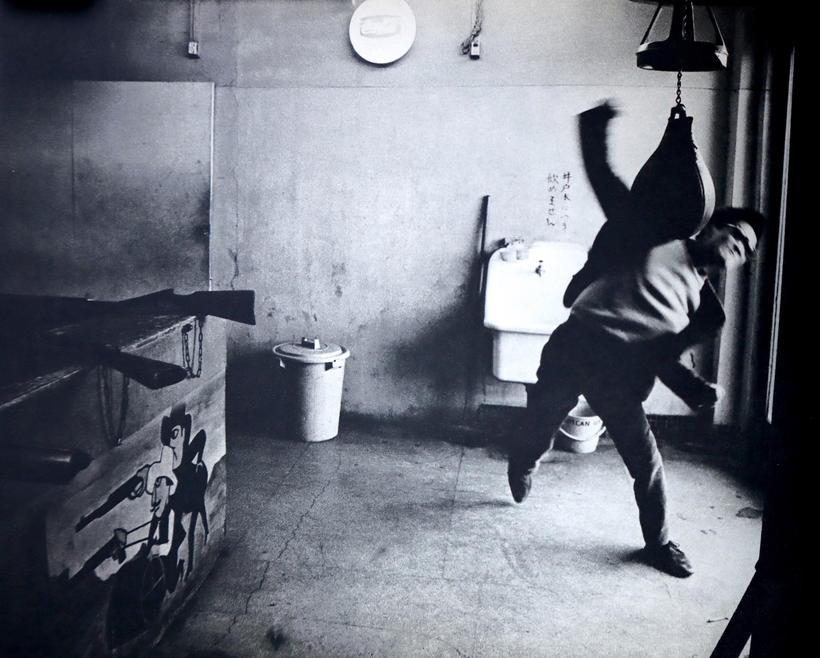Full Article with More Images on Patreon

It is essential to understand the biography of Tomatsu to understand what the emotion of rage or anger may be prevalent in his work. As a pubescent teen during the atomic bombing of Japan and the subsequent end of the Second World War, Tomatsu recalls the occupation of the American military forces from a position of exacerbation. Further, one can sense his state of lament over the subsequent loss of Japanese autonomy associated with the decades following the introduction of American imperialism. If one is aware of the position of Japan during the 50s and 60s through the early 70s, as a nation used to further American hegemony as a platform for other wars such as the Korean War and later the Vietnam War, it is no surprise that the Japanese people, themselves “losers” defined by an epic moment of historical devastation, would see the occupation and their geography as an unfortunate aid to further distribution of destruction through inconvenient American warmongering.
 Though the financial years following the war, mainly the 70s, and 80s, were by all accounts considered something miraculous until the property crisis of the 1990s, the period was associated with a heavy set of cultural costs, namely the loss of traditional identity in the wake of forceful importation of Western capitalism, and complicity with the continued export of war to other Asian nations under duress of the American occupation. I believe one can read into several works from the late 1960s and early 1970s that showcase a particular type of aesthetic dissatisfaction or anger at the situation. Notably, this period kicked off in the mid-1960s with the publication of Kawada Kikuji’s Chizu, and ostensibly Nagasaki 11:02 by Tomatsu, both books being a subjective look back at the legacy of the atomic bomb and its effects on the people and landscape of Japan. Both books carry a distinct use of atmosphere and subjectivity that can be read as a personal response to the event (post) and the two decades that followed. Though neither book explicitly caters to anything outside of a type of reflection, the mood is unrelenting, choking, and the results point to something like cynicism encased by the hard-edged cocoon of mourning. Notably, both books follow the production of the film Hiroshima, Mon Amour (1959), which similarly plays with a strange type of flashback and heavy atmosphere of doubt and the occasional use of historical violence with victims of the bombs re-enacted during a film within the film. There is also a shared determination to use museums as storehouses for objects affected by the bomb, an illustrated type of living dead history…
Though the financial years following the war, mainly the 70s, and 80s, were by all accounts considered something miraculous until the property crisis of the 1990s, the period was associated with a heavy set of cultural costs, namely the loss of traditional identity in the wake of forceful importation of Western capitalism, and complicity with the continued export of war to other Asian nations under duress of the American occupation. I believe one can read into several works from the late 1960s and early 1970s that showcase a particular type of aesthetic dissatisfaction or anger at the situation. Notably, this period kicked off in the mid-1960s with the publication of Kawada Kikuji’s Chizu, and ostensibly Nagasaki 11:02 by Tomatsu, both books being a subjective look back at the legacy of the atomic bomb and its effects on the people and landscape of Japan. Both books carry a distinct use of atmosphere and subjectivity that can be read as a personal response to the event (post) and the two decades that followed. Though neither book explicitly caters to anything outside of a type of reflection, the mood is unrelenting, choking, and the results point to something like cynicism encased by the hard-edged cocoon of mourning. Notably, both books follow the production of the film Hiroshima, Mon Amour (1959), which similarly plays with a strange type of flashback and heavy atmosphere of doubt and the occasional use of historical violence with victims of the bombs re-enacted during a film within the film. There is also a shared determination to use museums as storehouses for objects affected by the bomb, an illustrated type of living dead history…